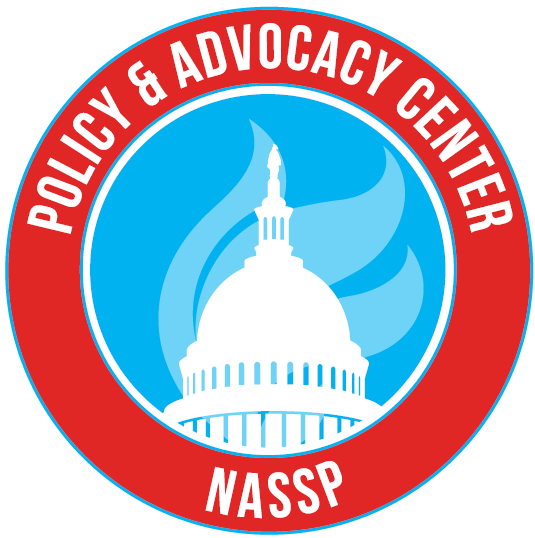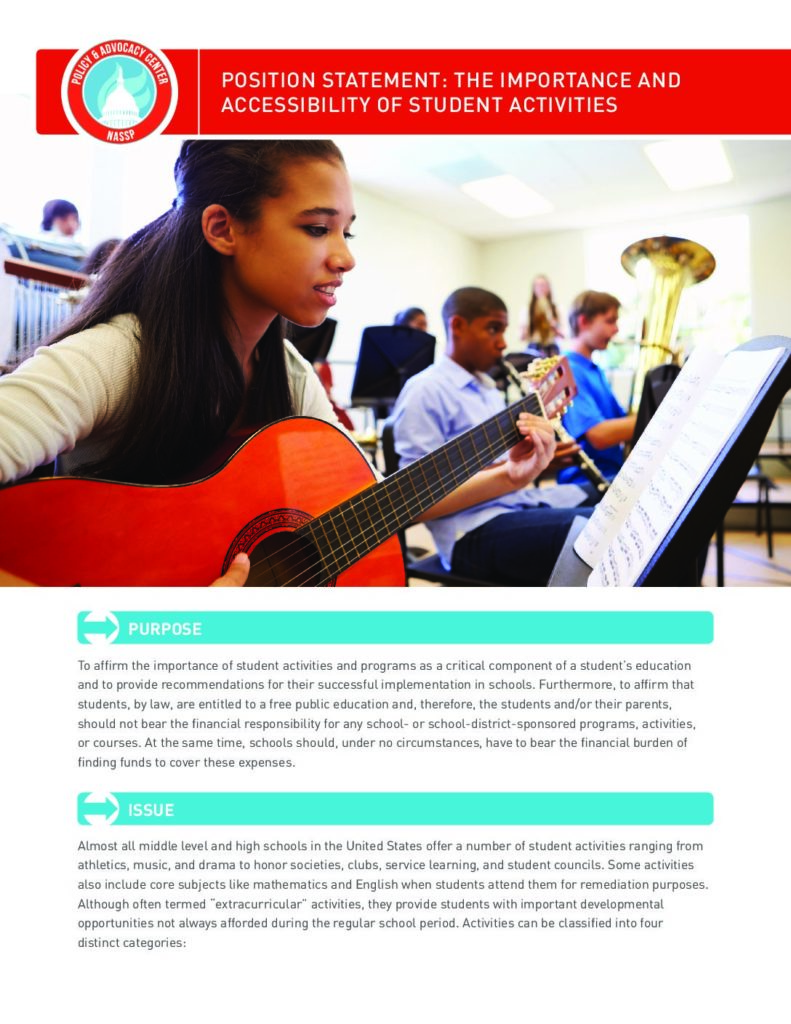To affirm the importance of student activities and programs as a critical component of a student’s education and to provide recommendations for their successful implementation in schools. Furthermore, to affirm that students, by law, are entitled to a free public education and, therefore, the students and/or their parents, should not bear the financial responsibility for any school- or school-district-sponsored programs, activities, or courses. At the same time, schools should, under no circumstances, have to bear the financial burden of finding funds to cover these expenses.

Almost all middle level and high schools in the United States offer a number of student activities ranging from athletics, music, and drama to honor societies, clubs, service learning, and student councils. Some activities also include core subjects like mathematics and English when students attend them for remediation purposes. Although often termed “extracurricular” activities, they provide students with important developmental opportunities not always afforded during the regular school period. Activities can be classified into four distinct categories:
- Direct extensions of required or elective courses (e.g., science club, math club, dance club), including opportunities to participate in student recognition programs (e.g., National Honor Society, Quill and Scroll, Spanish Honor Society, Tri-M Honor Society). This includes programs, courses, or activities that provide a recognized service to the community.
- Clubs or activities that are expressions of student interest that may be interdisciplinary in nature or not have a direct curricular link (e.g., popular music club, skateboarding club).
- Student council or student government that serve as opportunities for students to engage in the democratic process and have a voice in the life of the school to the extent allowable by law, policy, or tradition.
- Interscholastic and intramural athletics that provide students opportunities for development through sport (e.g., football, track, tennis, cheerleading).
It is important to note that NASSP uses student activities in place of extracurricular—sending forth a clear message that all programs, activities, and courses, which are sponsored by the school or school district, should align with their mission. In effect, it is NASSP’s position that they not be seen as “extra” in nature.
Research has documented the academic and social benefits of student activities. Students who participate in these activities achieve higher grades, are more motivated, have fewer discipline problems, are less likely to drop out of school, and are more likely to graduate and apply to college. The benefits are particularly significant for at-risk students, for whom student activities have been found to reduce juvenile crime, provide a sense of connectedness to the school, increase self-esteem, and create positive social networks they might not otherwise have. Activities can represent an important way to engage students who are at risk of dropping out. Funding for these school-sponsored activities has traditionally been generated through a variety of sources, including regular budget allocations, fundraising events, and revenues from vending machines. With shrinking budgets and a trend away from vending machines, schools have been struggling to keep activities available to students and have tended to make up for shortfalls by charging fees in order to maintain these offerings. This trend has been coined “pay for play.” Fees can range widely (from $15 to $2,000 a year) and are sometimes assessed to all students but, more frequently, only to those students who wish to participate in activities.
The pay-for-play trend has triggered a legal, philosophical, and educational equity debate. The question centers on whether student activities are part of the free public school system to which everyone is entitled by law. Those in favor of assessing fees argue that activities are not a fundamental part of the education process rising to the level that would require them to be provided at no cost. Those opposed to the pay-for-play system argue that student activities are as important to the school program as academic classes. The debate remains open and states vary widely in their definition of free education. California, New York, and Oklahoma require that any school-sponsored curricular or cocurricular activity be offered free of charge. Other states consider that such activities are not essential, therefore should not necessarily be publicly funded. Furthermore, the pay-for-play model is not being implemented uniformly in states where it is allowed. School districts tend to implement pay-to-play on an as-needed basis, creating further inequities from district to district.
Guiding Principles
- Middle level and high schools provide for social, health, emotional, as well as academic needs. Student activities are integral to an education, providing opportunities for all students enrolled to support and extend academic learning.
- Student activities are educational in nature and should be considered part of the school’s core mission.
- Student activities support the goal of teaching students to be responsible and give them opportunities that develop character, critical thinking, problem-solving, team building, and leadership skills.
- Research has shown a strong relationship between participation in student activities and academic achievement. Student activities also enhance the attendance and educational mission of schools. They play an important role in mitigating risk factors for at-risk students.
- America’s educational system is rooted in a commitment to a system of free public education with equal access for all students.
- American public schools educate 90 percent of all students and offer opportunities to develop social, cognitive, artistic, athletic, and leadership skills.
- American public schools seek to educate all students through programs, activities, and courses—regardless of socioeconomic, ethnic, gender, or racial status. Appropriate, reliable resources should be provided to fulfill such an important function at schools.
Recommendations
Recommendations for Policymakers
- State agencies should make resources available to public schools for the purpose of providing students with an array of school-sponsored activities that complement the curriculum. Schools should, under no circumstances, have to bear the financial burden of finding funds to cover these expenses.
- Recognize all activities approved by a middle level or high school for their contributions to the school’s overall goals for young people.
- Encourage administrators, educators, student activity advisers, and the general public to use the term “student activities” instead of “extracurricular activities.” Student handbooks, school documents, and other communication should reflect this more current and accurate terminology.
- Any program, activity, or course sponsored by the school or district—regardless of when it is offered—must be paid for with public funds. Such costs should not be the responsibility of students and their parents. School districts should be allowed to develop their own frameworks and processes around access or level of participation in student activities that they allow for individual students not enrolled in a school to participate. State governments and state athletic associations should respect these decisions and not create one-size-fits-all policies.
Recommendations for District Leaders
- Encourage schools to engage as many students as possible in student activities and athletics, and offer sufficient variety to appeal to a wide range of student interests.
- Advocate for reasonable and appropriate funding that will allow schools to offer important student activities and athletics.
Recommendations for Principals
- Ensure staff directing student activities receive professional development in the area of responsibility and appropriate compensation for the work provided while fulfilling this supervisory duty.
- Avoid establishing a hierarchy of student activities that leads to funding competition.
- Ensure that student activities are age-appropriate; non-discriminatory; well-planned, organized, and implemented; supervised by professional staff; and evaluated on a regular basis.
- Encourage students, particularly those at-risk or disengaged, to participate in student activities.
Resources
\[i\]
\[ii\] U.S. Census Bureau, May 17, 2007. http://www.census.gov/Press-Release/www/releases/archives/population/010048.html
\[iii\] National Center for Education Statistics: Trends in the Achievement Gaps in Reading and Mathematics, 2006. http://nces.ed.gov/programs/coe/2006/section2/indicator14.asp
\[iv\]IES National Center for Education Statistics, 2007. Indicator 23.
\[v\] Balfanz, R. &Letgers, N., 2004. Locating the Dropout Crisis. http://web.jhu.edu/CSOS/graduation-gap/power/report70.pdf

